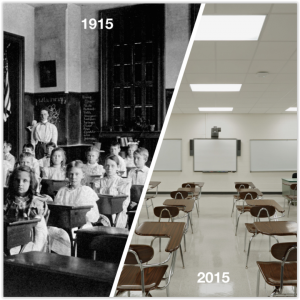When I first stepped into Ricky Thacker’s classroom, I was surprised by how unusual it looks. There are no desks. White boards hang from every wall. The entire room is painted bright orange and yellow, like candy corn.
Ricky stood in the middle of the room, calling out coordinates on a giant x-y axis he had taped to the floor as students rushed around him from quadrant to quadrant. Ricky’s enthusiasm inspired everyone else in the room. No one was sitting down. Everyone was engaged, including me.
Melinda and I visited Ricky’s classroom at Betsy Layne High School during our trip in November to Kentucky, where schools have been making some amazing progress. Since 2011, ACT scores have been going up. The graduation rate has risen from 80 percent to 86 percent since 2010, well above the national average of 81 percent.
We wanted to see what was driving all of these improvements. What we discovered is that one of the biggest reasons is great teachers—like Ricky Thacker.
The son of a coal miner, Ricky grew up in the Appalachian region of Eastern Kentucky. It’s a breathtaking region of mountains, rivers, and hidden valleys, but also deep poverty. In 2014, The New York Times ranked this region as one of the toughest places to live in America. Six counties in the region ranked among the bottom 10 in the U.S. in terms of income, educational attainment, unemployment, obesity, disability, and life expectancy. Over the last two decades, with the collapse of the coal industry, about half of the region’s population has moved away.
Ricky chose to stay. He went to college and became a teacher. He thought it would be the best way to make a difference in his community. And for the last nine years, he’s done just that.
Sitting in his classroom it was immediately clear that Ricky is passionate about his job, always pushing his students and himself to do better. His uniquely designed classroom is one example of what makes Ricky such a great teacher. Last summer, Ricky attended an education conference where a presenter displayed two photos: one of a classroom in 1915, and one from 2015.
Ricky was immediately struck, as you probably are, that the setup of American classrooms has not really changed in the last 100 years. Sure, new classroom technologies are available, but most students still sit in straight rows with a teacher at the front of the class.
When he returned to Betsy Layne, Ricky decided it was time to bring his classroom into the 21stcentury. He wanted to create a space that put students at the center. So he tossed out the desks and installed the white boards, where students can work together on algebra problems. As a final touch, his wife offered to repaint the classroom’s walls. She picked orange and yellow. “A math classroom should be full of energy,” she told him.
And it is. But Ricky’s was not the only classroom we saw like that.
During our visit, Melinda and I never spotted a teacher just standing in front of the class lecturing while the students just sat and listened. Instead, students were the ones doing the most work. They were actively engaged, sharing their ideas, solving problems, and, as a result, learning. Weeks after my visit, I still remember all the lessons vividly.
In a language arts class, the teacher sparked a lively debate about William Stafford’s poem “Traveling Through the Dark,” drawing everyone into the discussion, even finding clever ways to get the quiet kids engaged. Melinda visited a biology class where the teacher taught a lesson about how cells transport molecules across their membranes. As part of the lesson, she challenged students to put a piece of candy inside a paper bag without opening it. (It stumped nearly everyone—Melinda too!—but I’d bet that no one in the class will ever forget how a cell membrane works.)
Great teaching adds up to impressive achievements. Over the last 10 years, students from Floyd County, where Betsy Layne High School is located, have outperformed many of their peers across the state and the country. The county is ranked 12th among the state’s 173 public school districts based on academic performance, up from 145th in 2005. ACT scores continue to improve. And the high school graduation rate now tops 91 percent, 10 points higher than the national average.
What’s happening at Betsy Layne and other Kentucky schools show what’s possible when students are held to high standards and good teachers have the opportunity to become great. A longtime partner of our foundation’s education work, Kentucky is reaping the rewards of many years of investment in education reform. It set a high bar for what all students should know so they can be prepared for college or enter the workforce. Later, the state introduced a system which gives teachers the tools and support they need to sharpen their skills and become more effective in the classroom.
None of these changes have been easy. But in Kentucky, teachers, parents, and politicians have worked together to stay focused on the goal of giving students the best education possible. As one teacher told Melinda and me, “I want to create a school where I’d want to send my own kids.”
Teachers at Betsy Layne told me that their school’s focus on student-centered, hands-on learning has made their jobs easier. Instead of lecturing for hours every day, they now organize activities that leave them and their students more energized. It’s a win-win, they said.
Likewise, teachers say the professional development system is an opportunity for improvement, not a tool for punishment as some had feared. They observe each other’s classes to provide feedback and learn new techniques. Sometimes an approach used in a biology class might work well in a social studies class. They also survey their students to get input on their performance. Many teachers said they look beyond their schools for ways to get better at their craft. Through Twitter and other social media, they connect with other teachers in the state and across the country to exchange lesson ideas and discuss shared challenges.
What impressed me most is that no one at Betsy Layne is content standing still. They believe the best way to improve their school is to continue to improve themselves.
Still, they remain humble about what they’ve achieved. “We’re a diamond in the rough,” Ricky likes to say of his school. Maybe at one time that was true. But no longer. As an example for other schools to follow, it shines brightly.

